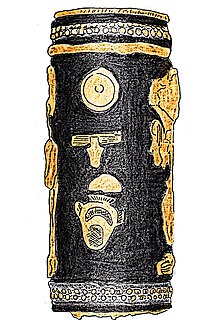Hotepibre
| Hotepibre Qemau Siharnedjheritef | |||||||||||||||||||||||||||||||||||||||||||||||||||||||||
|---|---|---|---|---|---|---|---|---|---|---|---|---|---|---|---|---|---|---|---|---|---|---|---|---|---|---|---|---|---|---|---|---|---|---|---|---|---|---|---|---|---|---|---|---|---|---|---|---|---|---|---|---|---|---|---|---|---|
| Sehotepibre Hornedjheritef | |||||||||||||||||||||||||||||||||||||||||||||||||||||||||
 Drawing of the ceremonial mace handle with Hotepibre's name, from Ebla | |||||||||||||||||||||||||||||||||||||||||||||||||||||||||
| Pharaoh | |||||||||||||||||||||||||||||||||||||||||||||||||||||||||
| Reign | 1 to 5 years possible,[1] 1791 BC - 1788 BC (Ryholt)[2] | ||||||||||||||||||||||||||||||||||||||||||||||||||||||||
| Predecessor | Ameny Qemau | ||||||||||||||||||||||||||||||||||||||||||||||||||||||||
| Successor | Iufni | ||||||||||||||||||||||||||||||||||||||||||||||||||||||||
| |||||||||||||||||||||||||||||||||||||||||||||||||||||||||
| Father | Ameny Qemau? | ||||||||||||||||||||||||||||||||||||||||||||||||||||||||
| Dynasty | 13th dynasty | ||||||||||||||||||||||||||||||||||||||||||||||||||||||||
Hotepibre Qemau Siharnedjheritef (also Sehetepibre I or Sehetepibre II depending on the scholar) was an
Family
Qemau Siharnedjheritef complete nomen means "Qemau's son, Horus he who seizes his power" and from this it is likely that he was the son of his predecessor
Attestations
There are several attestations of Hotepibre in Lower Egypt and exchange with the Northern Levant.
Lower Egypt
Khatana
A statue dedicated to Ptah and bearing the name of Hotepibre was found in Khatana, but its location of origin is unknown.
el-Atawla, temple-block
A Temple-block from
Tell el-Dab'a, palace
Hotepibre is sometimes also credited as the founder of a palace recently rediscovered at
Levant
Ebla (Inner Syria), ceremonial mace
This pharaoh is also known by a ceremonial mace found inside the so-called "Tomb of the Lord of the Goats" in Ebla, in modern northern Syria;[7] the mace was a gift from Hotepibre to the Eblaite king Immeya who was his contemporary.[8]
Speculations
According to egyptologists Kim Ryholt and Darrell Baker, he was the sixth king of the dynasty, reigning for one to five years, possibly three years, from 1791 BC until 1788 BC.[1][2] Alternatively, Jürgen von Beckerath and Detlef Franke see him as the ninth king of the dynasty.[9][10][11]
References
- ^ ISBN 978-1-905299-37-9, 2008, p. 120-121
- ^ a b K.S.B. Ryholt, The Political Situation in Egypt during the Second Intermediate Period, c.1800-1550 BC, Carsten Niebuhr Institute Publications, vol. 20. Copenhagen: Museum Tusculanum Press, 1997
- ^ Labib Habachi: Khatâ'na-Qantîr: Importance in Annales du Service des Antiquités de l'Égypte, Nr. 52 (1952), p. 460
- ^ See Ryholt (1997), pp. 73, 208, 214-215 and 284
- ^ See Ryholt (1997), p. 338, File 13/6
- ISBN 0924171464., pp. 397-398.
- ^ Ryholt, K. "Hotepibre - A Supposed Asiatic King in Egypt with Relations to Ebla", Bulletin of the American Schools of Oriental Research 311, 1998, pp. 1–6.
- ISBN 978-88-06-20258-3.
- ^ Jürgen von Beckerath: Untersuchungen zur politischen Geschichte der zweiten Zwischenzeit in Ägypten, Glückstadt 1964, p. 39–40, 231–32 (XIII 8)
- ^ Jürgen von Beckerath: Chronologie des pharaonischen Ägyptens, Münchner Ägyptologische Studien 46, Mainz am Rhein (1997)
- ^ Detlef Franke: Zur Chronologie des Mittleren Reiches. Teil II: Die sogenannte Zweite Zwischenzeit Altägyptens, in Orientalia 57 (1988)
